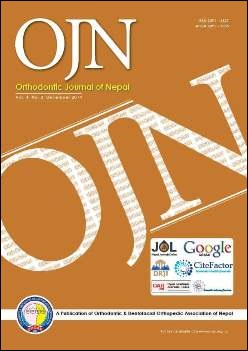Prevalence of Malocclusion and Orthodontic Treatment Needs in Down Syndrome Sudanese Individuals
DOI:
https://doi.org/10.3126/ojn.v4i2.13896Abstract
Objective: To determine prevalence of malocclusion and orthodontic treatment needs in Down syndrome individuals among Sudanese population in Khartoum area.
Materials & Method: A total of 75 (37 males and 38 females) Down syndrome individuals age ranging from 6-28 years were clinically examined after obtaining their guardian’s consent, malocclusion was determined based on Angle and Incisor classification. Exclusion criteria were included individuals who had history of extraction and orthodontic treatment.
Data was analysed by using SPSS Version 17, at an alpha level 0.05 and 95% confidence limits.
Result: Angle Class III and Incisor III malocclusion represents the most prevalent type of malocclusions (58.7%) Angle classification, (53.3%) Incisors classification. Angle Class III malocclusion was more frequent among females (60.5%) than in males (56.8%). The
majority of individuals with Down syndrome are in need of orthodontic treatment (85.3%).
Conclusion: The prevalence of malocclusion and orthodontic treatment need among Sudanese Down syndrome individuals was high. Angle and Incisor Class III malocclusion representing commonest trait of malocclusion with more frequency in females
than males.
Key word: down syndrome, Class III malocclusion, orthodontic treatment
Downloads
Downloads
Published
How to Cite
Issue
Section
License
Copyright © held by Orthodontic & Dentofacial Orthopedic Association of Nepal
- Copyright on any research article is transferred in full to the Orthodontic & Dentofacial Orthopedic Association of Nepal upon publication in the journal. The copyright transfer includes the right to reproduce and distribute the article in any form of reproduction (printing, electronic media or any other form).
- Articles in the Orthodontic Journal of Nepal are Open Access articles published under the Creative Commons CC BY License (https://creativecommons.org/licenses/by/4.0/)
- This license permits use, distribution and reproduction in any medium, provided the original work is properly cited.




